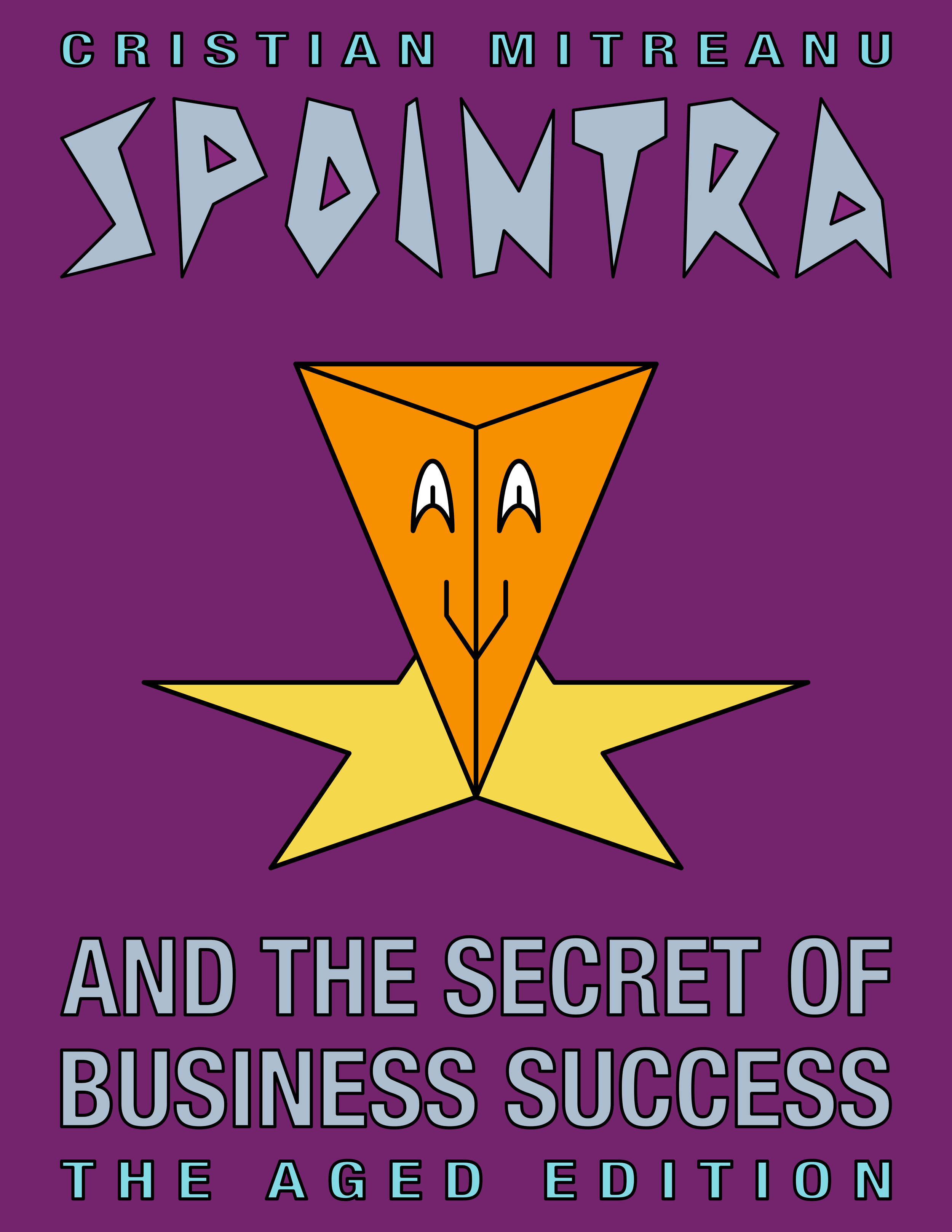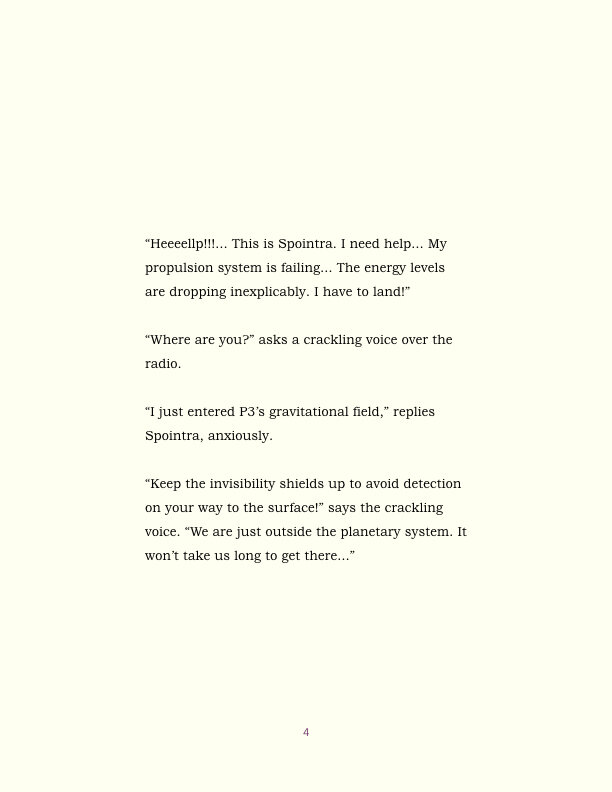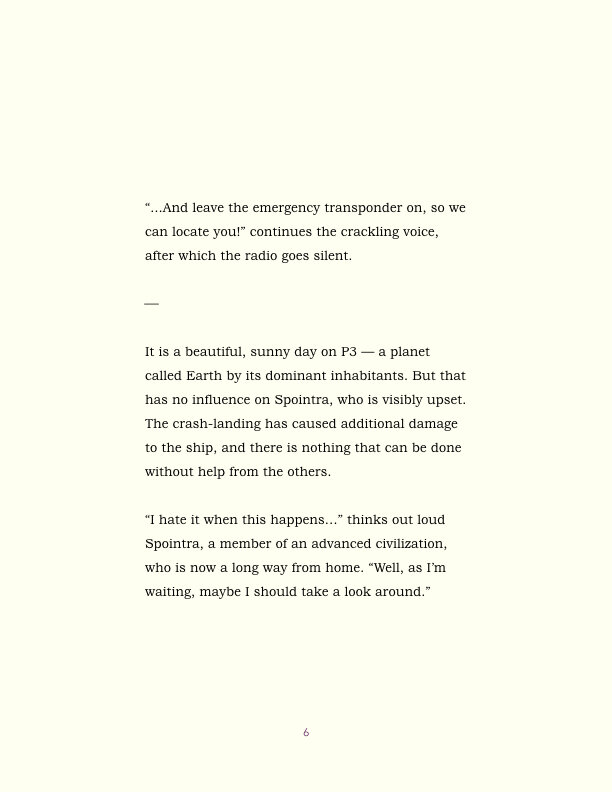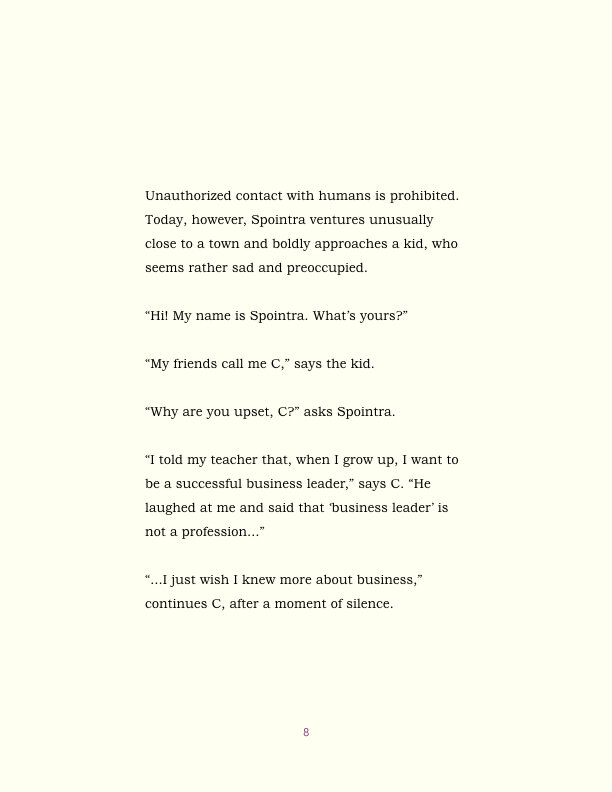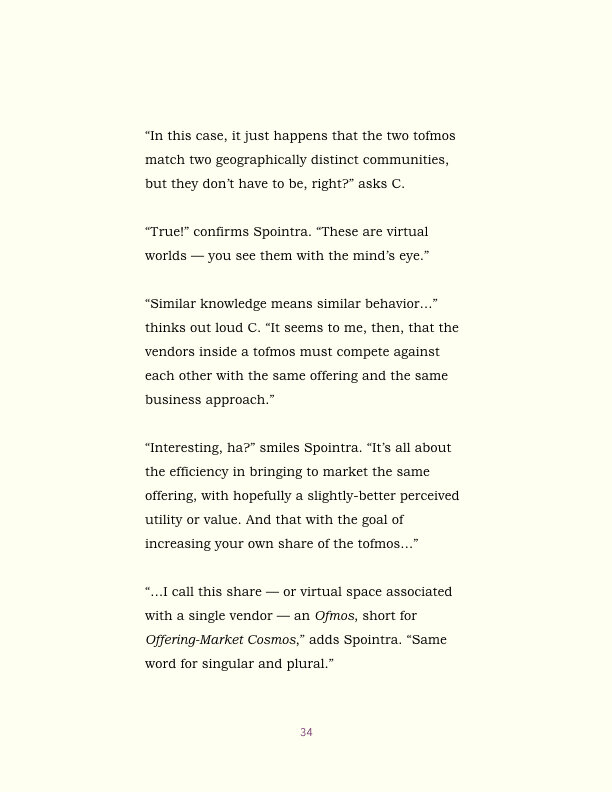RedefiningStrategy.com™ — The Business Big Picture Toolkit™

Spointra and the Secret of Business Success
Description from Apple Books (2013):
Spointra and the Secret of Business Success (The Aged Edition) aims to capture the smallest amount of knowledge that explains the largest amount of phenomena in the business world. It is the 20 that explains the 80. It is concise, yet entertaining. A children's book for grown-ups, this "aged" revision of the 2007 first edition details a fundamental theory of business that provides you with an integrated perspective on the basic behaviors of individuals, organizations, and economies.
For centuries, Europeans thought of their world as being flat; and so, accordingly, all their possible solutions for reaching India pointed East. But once they learned that the Earth was round, new solutions to their problem emerged — they could also go West. Similarly, Cristian Mitreanu’s Spointra reveals a broader and more realistic business and economic worldview that will provide a comprehensive foundation for your story (as an individual, product, or company) and your strategies, thus increasing your odds of success in a rapidly-changing world.
Concepts and theories put forth by many influential thinkers such as Peter Drucker, Michael Porter, and Clayton Christensen can now be brought together meaningfully on this unifying platform, which Mitreanu assembles by keeping the focus of his rationale on behaviors, at the individual and then at the aggregate level. But the book’s innovative character goes beyond the novel models that explain how individuals, organizations, and economies respectively work. As a vehicle, Spointra is brief, yet dense. Just like a favorite Dr. Seuss book, it invites repeat readings, bringing to light new insights every single time.
Mitreanu has worked on these theories for over a decade now, publishing the first edition of the book, Spointra and the Secret of business Success, in April 2007 in a short-run of 500 hardcover copies. The current, second edition includes several refinements, with the most significant being the replacement of the term “issue” with the term “need.”
Spointra and the Secret of Business Success (The Aged Edition)
ISBN 978-0-9792429-1-5 | Published as a digital book in December 2013 in San Francisco, CA, USA
Spointra and the Secret of Business Success
ISBN 978-0-9792429-0-8 | Published as a limited edition of 500 copies in April 2007 in Chicago, IL, USA
The 2013 “aged” edition of Spointra was intended to come with a letter to the reader at the end. While the development of the ”Beyond the Fun” letter was put on hold after the first iteration, Cristian Mitreanu has made public that first draft manuscript to provide a more in-depth description of the new worldview and how it relates to the existing business and economic body of knowledge.
Read BEYOND THE FUN (PDF, Draft Manuscript, May 2013)
Spointra and the Secret of Business Success
(The Aged Edition)
December 8, 2013
Front Cover
Inner Cover
Page 1
Page 2
Page 3
Business plays a major role in people’s lives. It is everywhere.
Quickly becoming a matter of basic education, a sound understanding of the business world weighs heavily on one’s successful existence.
But making sense of the big picture is challenging. Luckily, deeper insights often come from unexpected places, at unexpected times.
Page 4
Page 5
“Heeeellp!!!... This is Spointra. I need help... My propulsion system is failing... The energy levels are dropping inexplicably. I have to land!”
“Where are you?” asks a crackling voice over the radio.
“I just entered P3’s gravitational field,” replies Spointra, anxiously.
“Keep the invisibility shields up to avoid detection on your way to the surface!” says the crackling voice. “We are just outside the planetary system. It won’t take us long to get there...”
Page 6
Page 7
“...And leave the emergency transponder on, so we can locate you!” continues the crackling voice, after which the radio goes silent.
⎯
It is a beautiful, sunny day on P3 — a planet called Earth by its dominant inhabitants. But that has no influence on Spointra, who is visibly upset. The crash-landing has caused additional damage to the ship, and there is nothing that can be done without help from the others.
“I hate it when this happens…” thinks out loud Spointra, a member of an advanced civilization, who is now a long way from home. “Well, as I’m waiting, maybe I should take a look around.”
Page 8
Page 9
Unauthorized contact with humans is prohibited. Today, however, Spointra ventures unusually close to a town and boldly approaches a kid, who seems rather sad and preoccupied.
“Hi! My name is Spointra. What’s yours?”
“My friends call me C,” says the kid.
“Why are you upset, C?” asks Spointra.
“I told my teacher that, when I grow up, I want to be a successful business leader,” says C. “He laughed at me and said that ‘business leader’ is not a profession...”
“...I just wish I knew more about business,” continues C, after a moment of silence.
Page 10
Page 11
“Hmmm,” quietly contemplates Spointra, who has studied humans for quite some time now.
“Well, your teacher was partially right — being a successful business leader is a mix of art and science… and luck” says Spointra. “Fortunately, there is more science to it than most people think. Would you like to talk about it?”
“Are you sure?” asks C.
“Yep!” replies Spointra, struggling to hide the excitement triggered by the thought of being able to directly influence the life of a human. “Let’s sit down on that bench, over there.”
“Coool!!!” replies C with enthusiasm.
Page 12
Page 13
“You see, success in business remains a fuzzy subject for many,” begins Spointra.
“Why?” asks C.
“Human interactions play a major role in business, making everything seem somehow chaotic,” replies Spointra. “However, many people fail to realize that there is a significant degree of predictability in those dynamics… And I will show you a basic logic or explanation of how things work that is universally valid.”
“Really!?” wonders C.
“Yes,” confirms Spointra. “I will give you the secret of enduring success in business… I will give you the tools to successfully perform the two foundational tasks of a business leader — understanding the big picture and developing a guiding formula for the organization…”
Page 14
Page 15
“...Relax, C! It’s not that complicated. I promise,” continues Spointra.
“I hope so!” smiles C, visibly nervous.
“So, as you probably know, in simple terms, business means producing or buying something, and then selling it for a profit,” explains Spointra.
“Yes. The vendor’s profit or loss is the price paid by the customer minus the cost associated with producing, or buying, and then selling the offering,” shows off C.
“Correct,” replies Spointra. “Yet, it all comes down to the transaction between the vendor and the customer — no transaction, no business!”
Page 16
Page 17
“So we have to make sure that the customer actually needs or, even better, wants the offering, right?” asks C.
“We must go beyond that! We must understand how customers address their needs, in general,” replies Spointra.
“Okay…” reluctantly agrees C.
“You see, all needs are generated through both disaggregation and aggregation…” says Spointra. “You need a home office. What do you do?”
“Uhhh... I would start shopping for a desk, a computer, a printer…” struggles C.
“Exactly!” confirms Spointra. “You break the complex need down into smaller and clearer component needs…”
Page 18
Page 19
“...At the same time, however, your idea of ‘home office’ is already shaped by the possible components that you are currently aware of,” continues Spointra.
“You mean, if I’m set on a particular type of computer, my need ‘home office’ will fit that constituent need,” says C.
“You got it! A laptop would suggest a need for a smaller desk or a more compact home office, right?” clarifies Spointra.
“Can we say, then, that a need is shaped by both one’s personal ideals as well as his or her environment?” wonders C.
“Yes,” replies Spointra. “A need is a constant compromise that is fueled by the drive to make the most out of the given circumstances — a basic drive that’s shared by all living things...”
Page 20
Page 21
“...And that’s how every individual develops a unique hierarchy of needs called the Tree of Needs…” continues Spointra. “So, in business, every customer has one. Individuals and organizations.”
“I’m not sure I follow,” worries C.
“Making the most of the given circumstances is, in fact, a quest for success,” explains Spointra. “One’s needs are all part of an overarching need called Successful Existence, and are all structured by their levels of specificity.”
“So the needs that are positioned at the lower levels are more specific. There, the need aggregation and disaggregation is more granular… Still, the needs at any given level should roughly add up to the need ‘successful existence’… I see it,” smiles C.
Page 22
Page 23
“Yes, these virtual levels are distributed along a Continuum of Need-Generating Behaviors,” says Spointra. “At the top, the needs have no known direct solutions. So the customer resorts mostly to breaking them down into simpler — yet still ideal and unique — component needs.”
“So, the resulting needs too do not have known direct solutions,” adds C.
“Yep!” agrees Spointra. “As we get to the middle of the continuum, however, there is as much disaggregation as there is aggregation, and the needs become equally defined by what the customer considers ideal and what can actually be addressed with known offerings.“
“At the bottom of the continuum, then,” shows off C again, “the process is primarily one of matching needs to offerings that are known and available...”
Page 24
Page 25
“...But, hold on, Spointra!” continues C, worried. “I can’t really figure out my own tree of needs.”
“That’s normal. The higher-positioned needs are hard to clearly define because they are complex, encompassing all the needs below,” replies Spointra. “Then, on top of that, you have the fact that the entire structure is dynamic — it evolves continuously.”
“What do you mean?” asks C.
“Knowledge accumulation occurs naturally, and the environmental changes are continuous. Under the influence of both, the customer adjusts the hierarchy of needs or, equivalently, the overarching need ‘successful existence’,” explains Spointra. “As a result, some needs become irrelevant and are thus discarded...”
Page 26
Page 27
“...The remaining ones evolve within the hierarchy until they are addressed,” continues Spointra. “Or, they might be discarded before that.”
“How does a need evolve?” asks C.
“It becomes more specific,” promptly replies Spointra. “The accumulation of knowledge allows the customer to make the most out of the offering — product or service — associated with the need, reducing its perceived utility to a clearer, core functionality. As a result, the need is pushed lower within the overall structure of needs.”
“I think that makes sense…” agrees C.
“Now, there’s also an opposing pressure,” says Spointra. “Aiming to maximize the associated gains, the vendor adds new functionality to the offering, increasing its perceived value and thus pushing the corresponding need upwards along the continuum…”
Page 28
Page 29
“...However, over time, as the related knowledge spreads among individuals, the need will move toward lower hierarchical levels. From the marketplace perspective, collectively, the customer pressure always wins,” continues Spointra.
“And, during this process, the customer behavior changes as well, right?” checks C.
“Right,” confirms Spointra. “Much like the behavior of the average kid has changed relative to the average computer. Years ago, one had to consult with a sales associate to better grasp the computer’s usefulness and only then make a buying decision.”
“Really!?” wonders C.
“Crazy times!” smiles Spointra. “Today, a computer’s utility is pretty clear to most kids... And that evolution in knowledge and behaviors that took place over the years is a process called Commoditization.”
Page 30
Page 31
“Hmmm. So, that is what is happening…” contemplates C.
“Yep!” confirms Spointra. “However, for a transaction to occur, it’s not enough to match an offering to a need. A vendor’s business approach must also match the customer’s behavior.”
“Hold on! A vendor usually deals with a lot of customers, each one being rather unique,” argues C. “Isn’t it true that you can’t be everything to everyone?”
“Excellent, C!… Business is about profit and perpetual survival, and implicitly about wealth accumulation,” replies Spointra. “That’s why a vendor usually deals with more than one customer… Fortunately, although you can’t be everything to everybody, customers are not as different from each other as you might think...”
Page 32
Page 33
“...Humans are social creatures, who tend to form lasting communities,” continues Spointra. “As a result, the levels of knowledge associated with a need and the corresponding offering tend to be similar within the same community.”
“Then, the need-generating behaviors tend to be similar too,” adds C, confidently.
“Exactly!” agrees Spointra. “And that sets the foundation for the concept of Tofmos or Total Offering-Market Cosmos, which is a virtual entity defined by an offering and a set of customers with a similar need-generating behavior relative to that offering… Much like your communities Bluerock and Redwood, with each one having its own, unique general level of knowledge relative to the need and offering ‘computer’…”
“…So, through the lenses of the new worldview,” adds Spointra, “the two communities with their inhabitants and the companies selling computers there can now be seen together as two distinct virtual spaces or worlds — two tofmos.”
Page 34
Page 35
“In this case, it just happens that the two tofmos match two geographically distinct communities, but they don’t have to be, right?” asks C.
“True!” confirms Spointra. “These are virtual worlds — you see them with the mind’s eye.”
“Similar knowledge means similar behavior…” thinks out loud C. “It seems to me, then, that the vendors inside a tofmos must compete against each other with the same offering and the same business approach.”
“Interesting, ha?” smiles Spointra. “It’s all about the efficiency in bringing to market the same offering, with hopefully a slightly-better perceived utility or value. And that with the goal of increasing your own share of the tofmos…”
“…I call this share — or virtual space associated with a single vendor — an Ofmos, short for Offering-Market Cosmos,” adds Spointra. “Same word for singular and plural.”
Page 36
Page 37
“If inside an ofmos, at any given time, every customer has a similar behavior relative to the defining offering, then the offering’s position on the continuum of need-generating behaviors will be the same for all customers,” says C.
“Very good!” approves Spointra. “Which means that these virtual business spaces can be uniquely represented on the continuum. They are distinct entities. And so, like the offerings that defines them, they will commoditize as well...“
“...Think about it!” continues Spointra. “You can now see a vendor’s ‘computer’ business in Bluerock and Redwood as two ofmos, instead of a multitude of individual transactions.”
“That’s so much easier!” enthusiastically agrees C.
Page 38
Page 39
“Easier and very important!” says Spointra. “Any company can be seen as a portfolio of ofmos… The traditional view with the two distinct portfolios of offerings and customers — both different in nature and dynamics — can now be translated into a single, unifying portfolio of ofmos.”
“Commoditizing ofmos,” adds C.
“Exactly!” agrees Spointra. “Always think of a company or business as a portfolio of ofmos... Visually, just imagine a collection of floating orbs that, as a loose group, slowly descend along the continuum of need-generating behaviors. Each orb represents a unique virtual world, which requires excellence in a particular business approach — an approach that must change as the orb’s position relative to the continuum changes.”
Page 40
Page 41
“And each orb generates a stream of revenue and, with it, a stream of profit or loss, right?” asks C.
“Right. Very good!” confirms Spointra. “Which leads us to the next step…”
“…Over time, as the ofmos in a vendor’s portfolio commoditize,” continues Spointra, “factors like limitation of resources, experience with certain offerings and business approaches, and aversion to change tend to lead to the formation of a cluster of ofmos with need-generating behaviors that fall within the same vicinity… This commoditizing cluster is where most of the vendor’s revenue tends to be concentrated. And I call it the Ofmos Portfolio Center or, simply, the Center.”
“Center as in Center of Gravity — it makes perfect sense...” observes C.
Page 42
Page 43
“...So, by using the Center, we can further simplify the way we see a company,” continues C.
“Not bad, ha?” smiles Spointra. “Yes, the Center emerges from the company’s efforts to better perform at the tofmos level, and it is a reflection of its day-to-day activity... However, a business is also characterized by intent. The limitation of resources constrains the vendor to settle, deliberately or not, on an intended approach.”
“That makes sense,” realizes C.
“And that is what I call Ofmos Portfolio Focus or, simply, the Focus…” says Spointra. “And, with three generic areas of customer need-generating behaviors on the continuum, the intent tends to be framed from that perspective. In other words, the vendors do tend to settle on one of the three types of Focus.”
Page 44
Page 45
“If the Focus is what the vendor says, and the Center is what the vendor does, shouldn’t they match?” wonders C.
“Very sharp, C!” replies Spointra. “Indeed, for a company to be healthy, its Focus and its Center must be aligned. Consistently generating profits and positive cash flows is possible only if the intent matches the business approach that emerges from the daily operations… I call that Ofmos Portfolio Alignment or, simply, the Alignment.”
“And since there are three options for the Focus, we should also have three types of Alignment,” adds C with confidence.
“Yep!” confirms Spointra. “Remember, though, aligning a company’s Focus and its Center is just the first step. You also have to sustain that alignment.”
Page 46
Page 47
“What do you mean?” asks C.
“The alignment between Focus and Center is an unstable state of affairs,” explains Spointra. “While the Focus is relatively fixed, representing the vendor’s intent, the Center commoditizes, just like the ofmos that define it. Consequently, over time, the two tend to move out of alignment.”
“Change your Focus!” suggests C.
“Sure, but that’s uncommon,” says Spointra. “Most companies, in the way they are organized and managed, are guided by their Focus… So, a more sustainable option is to adjust the Center’s position by changing the composition of the ofmos portfolio. And, in most cases, that means removing the ofmos that descended too low, while adding new ones at higher levels...”
Page 48
Page 49
“...And that’s it! This is the basic toolkit, the fundamental knowledge that will empower you in your quest for success,” adds Spointra.
“That’s it!?” panics C. “Uhhh... Right now, all this stuff seems a bit fuzzy to me.”
“Start with the big picture, the overall dynamics,” explains Spointra. “You know that every offering commoditizes relative to a set of customers — which allows you to see the world as a multitude of tofmos, inside which the number of customers, the competition, and the profits tend to go up and then down… until the defining offerings become irrelevant or obsolete.”
“I think I got it!” says C. “This dynamic worldview integrates all the elements of the business environment, with its opportunities and risks. So, if the economy is a collection of tofmos, then every company is a collection of ofmos.”
Page 50
Page 51
“Yep!” replies Spointra. “Nevertheless, to achieve lasting success in business, you need to act on that insight. You need a formula, a recipe… Specifically, you must achieve and sustain an alignment between the company’s Focus and its Center!”
“Oh, that’s right!” remembers C.
“Alignment means healthy business,” continues Spointra. “Attain one of the three types of Alignment, and then sustain it over time!”
“And that could be done by adjusting the company’s selection of offerings or customers, or both…” adds C with confidence.
“Cool!” continues C. “And I can apply this explanation to any company, in any industry.”
“Correct!...” confirms Spointra.
Page 52
Page 53
“...This new perspective on how companies and economies fundamentally work is universally valid, regardless of timeframes and circumstances,” continues Spointra.
“Great! Thank you, Spointra!” replies C.
“Sure. It is a comprehensive theory of business that bridges the gap between a company’s CEO-driven intended behavior and its marketplace-driven emergent behavior… the gap between planning and execution…” explains Spointra. “You can now think beyond the offering level… With these new insights, you will have an edge over the many CEOs and their companies that remain oblivious as they drift into unattractive business spaces — which is why success for many tends to be only temporary.”
—
“Spointra, where are you?” bursts a radio transmission through the air. “We fixed it…”
Page 54
Page 55
C decides to walk with Spointra back to the ship. On the way, they exchange some final thoughts.
“So, this new worldview and set of theories should help me become a successful business leader,” contemplates C, visibly overwhelmed, but excited.
“Uh-huh!” confirms Spointra. “It will help you develop a sound understanding of the business world — how individuals behave, how markets behave, how organizations behave, and even how economies behave… Moreover, based on the big picture, you will know how to act, which will considerably increase your chances of success…”
“...Now, I leave you with this: Think unique virtual worlds! Think floating orbs and clusters!” continues Spointra, while disappearing inside the ship. “Visualize! Always visualize…”
Page 56
Page 57
“The council of elders will not be happy about this…” says the crackling voice over the radio. “Direct contact is forbidden, remember?”
“Yep!” confirms Spointra.
“Oh, please!” erupts the crackling voice. “Stop talking like that!… You were supposed to study them, not become one of them.”
“Sorry, Father!” apologizes Spointra.
Then, a heavy silence settles in.
—
“Anyway…” sounds the radio moments later. “Your new friend will grow up to be very successful…”
Spointra smiles and whispers, “See you soon, C!”
Page 58
Page 59
Page 60
Inner Cover
Back Cover

